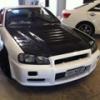Jaycar Boost and Fuel Control
Announcements
-
Similar Content
-
Latest Posts
-
I’m doing some side developments on SR20det S13 engines, its one my hobby cars used it to compare flow capacity of some smaller size wheels. SR20det is one of another JDM legendary engines I'm sure there are plenty of SR enthusiasts on this forum, I will share results some common turbo configurations here. a quick run down of what the car is: Wide body 180sx Type X with black top engine (blue). It has: Stock bottom end Haltech 1500 ECU 5-0 motorsports trigger kit Kelford SR20DET Beehive Spring with Titanium Retainers Kelford Cams SR20DET S13 188-B 268/272 Cams G25-660 Turbocharger in T2 .64 rear housing internally gated ARP Head studs MLS head gasket 1000CC ID injectors Walbro 450L Fuel pump Front mount cooler kit JJR’s 3 inches turbo back exhaust (its too short for the 180sx it had to be extended) Pump 98 fuel Hub Dyno tune So far made 270rwkws at 22psi full boost by 4500RPM. Engine is very knock limited hence a pretty bad looking top end. From previous experiences it seems like SR20dets are happier with bigger size turbine, some thing like a GT30 would make way better top end, but on same time response is lost. It won't be a problem with S15 VCT engines. I'll be testing alternative turbine housing, turbine wheel and possibly dump pipe options for extra flow to resolve the problem and of course E85 would resolve all the issues.
-
Awesome writeup and details. Thanks for sharing the story so far. I can relate to parts of it with my previous car and some of the issues I had to deal with.
-
Generally yes but for some reason I've been ruthless this time around! I might even need to do another tip run after the way I've finally been able to hit the delete button on shit I've stepped over, stepped around and tripped over for the past 10 years!
-






Recommended Posts
Create an account or sign in to comment
You need to be a member in order to leave a comment
Create an account
Sign up for a new account in our community. It's easy!
Register a new accountSign in
Already have an account? Sign in here.
Sign In Now